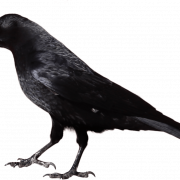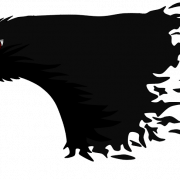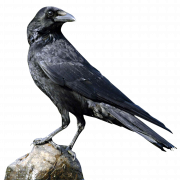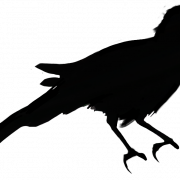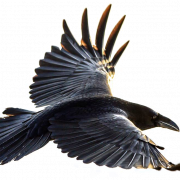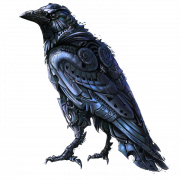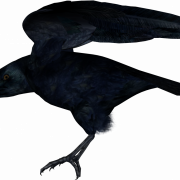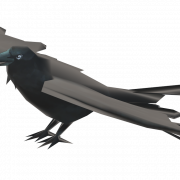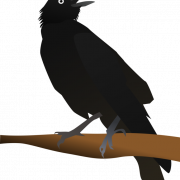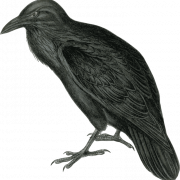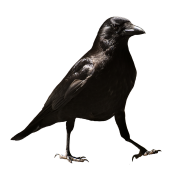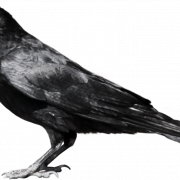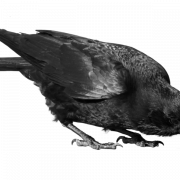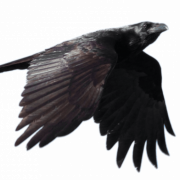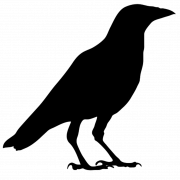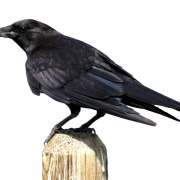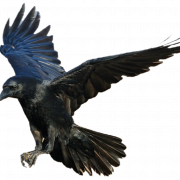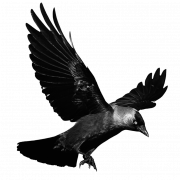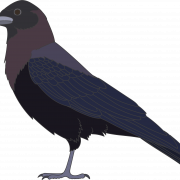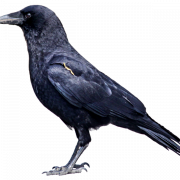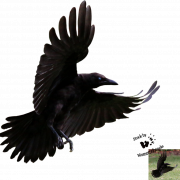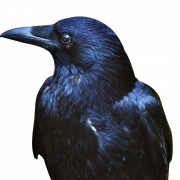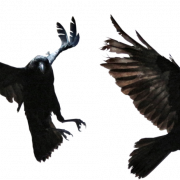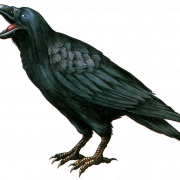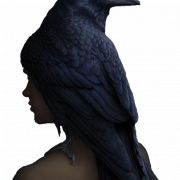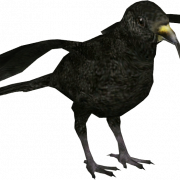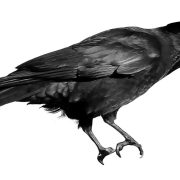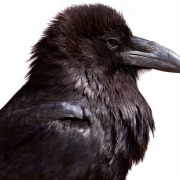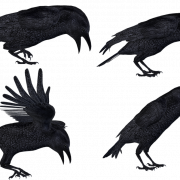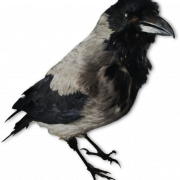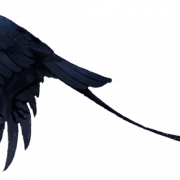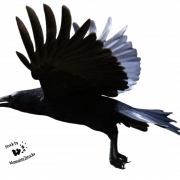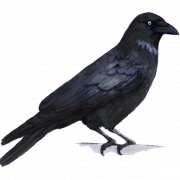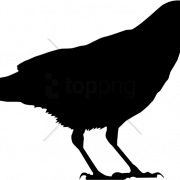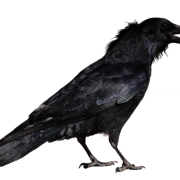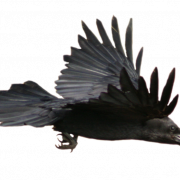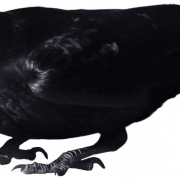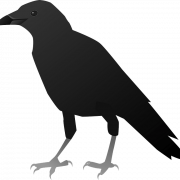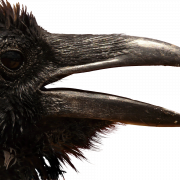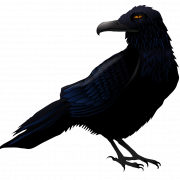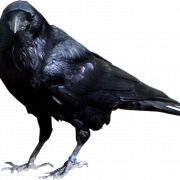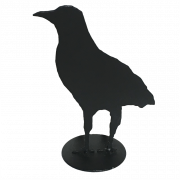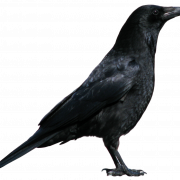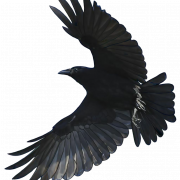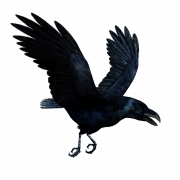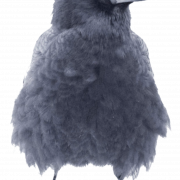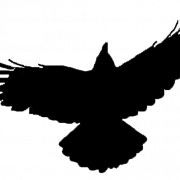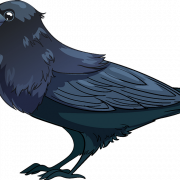Download top and best high-quality free American Crow PNG Transparent Images backgrounds available in various sizes. To view the full PNG size resolution click on any of the below image thumbnail.
License Info: Creative Commons 4.0 BY-NC
The American crow (Corvus brachyrhynchos) belongs to the Corvidae family of passerine birds. It’s a common bird that may be found in most of North America. The carrion crow and the hooded crow’s New World counterparts are American crows. The American crow and the hooded crow have comparable size, build, and activity, but their calls are distinct. Nonetheless, the American crow plays the same job in Eurasia as the hooded crow.
An American crow measures 40–50 cm (16–20 in) from beak to tail, with the tail accounting for about half of the total length. The weight varies between 300 and 600 grams (11 to 21 oz). Males are often bigger than females. CaaW!-CaaW!-CaaW! is the most common call.
The American crow has iridescent feathers and is completely black. It has a similar appearance to other all-black corvids. They may be recognized from the common raven (C. corax) by their size, from the fish crow (C. ossifragus) by the fact that they do not hunch and fluff their neck feathers when they call, and from the carrion crow (C. corone) by their size since the carrion crow is bigger and stockier.
Crows in the United States are abundant, broad, and vulnerable to the West Nile virus, making them an excellent bioindicator for tracking the infection’s spread. It is difficult for the virus to be transmitted directly from crows to people.
Christian Ludwig Brehm described the American crow in 1822. Its scientific name brachyrhynchos (‘billed’) is derived from Ancient Greek brachy- (‘short-‘) and rhynchos (‘billed’).
There are five subspecies that have been identified. Their bill proportions varied, and they form an approximate NE–SW clinal over North America. Birds in the extreme west and on the southern shore are the tiniest.
The northwestern crow, Corvus brachyrhynchos caurinus, was separated from its progenitors by Ice Age glaciation west of the Rocky Mountains. It’s only found in Pacific temperate rain forests, where it’s nearly supplanting the American crow. They only co-occur to some extent in the Seattle area. The voice has a distinct distinction.
Western North America, save the Arctic north, the Pacific Northwest, and the extreme south, is home to Corvus brachyrhynchos hesperis, the western crow. Smaller in size overall, with a thin beak and a low-pitched voice.
The American crow is a big bird with iridescent black feathers that cover its whole body. It has black legs, feet, and a black beak. They are 40–53 cm (16–21 in) long, with the tail accounting for roughly 40% of the total length. The wingspan ranges from 85 to 100 cm, while the wing chord is 24.5 to 33 cm (9.6 to 13.0 in) (33 to 39 in). The bill length varies greatly depending on the locale, ranging from 3 to 5.5 cm (1.2 to 2.2 in). The tarsus is 5.5–6.5 cm (2.2–2.6 in) long, while the tail is 13.5–19 cm long (5.3 to 7.5 in). The weight of a person can range between 316 to 620 grams (11.1 to 21.9 oz). Males are often bigger than females.
Download American Crow PNG images transparent gallery.
- Sitting American Crow PNG Image HD
Resolution: 1143 × 809
Size: 157 KB
Image Format: .png
Download
- American Crow Silhoutte
Resolution: 835 × 487
Size: 54 KB
Image Format: .png
Download
- American Crow PNG Free Download
Resolution: 2083 × 1970
Size: 1406 KB
Image Format: .png
Download
- American Crow Silhouette PNG Image
Resolution: 969 × 603
Size: 78 KB
Image Format: .png
Download
- Flying American Crow PNG Free Image
Resolution: 879 × 652
Size: 453 KB
Image Format: .png
Download
- American Crow PNG Picture
Resolution: 700 × 700
Size: 402 KB
Image Format: .png
Download
- American Crow PNG Free Image
Resolution: 990 × 758
Size: 525 KB
Image Format: .png
Download
- American Crow PNG File
Resolution: 1050 × 700
Size: 176 KB
Image Format: .png
Download
- American Crow Silhoutte Transparent
Resolution: 1164 × 994
Size: 26 KB
Image Format: .png
Download
- Vector American Crow
Resolution: 3456 × 2746
Size: 83 KB
Image Format: .png
Download
- American Crow PNG HD Image
Resolution: 1014 × 380
Size: 175 KB
Image Format: .png
Download
- Vector American Crow PNG
Resolution: 826 × 750
Size: 119 KB
Image Format: .png
Download
- Vector American Crow PNG Image
Resolution: 682 × 750
Size: 69 KB
Image Format: .png
Download
- American Crow PNG Pic
Resolution: 740 × 750
Size: 560 KB
Image Format: .png
Download
- American Crow PNG Download Image
Resolution: 725 × 720
Size: 242 KB
Image Format: .png
Download
- American Crow PNG High Quality Image
Resolution: 1024 × 662
Size: 378 KB
Image Format: .png
Download
- American Crow PNG Images
Resolution: 900 × 600
Size: 154 KB
Image Format: .png
Download
- Flying American Crow PNG File
Resolution: 850 × 551
Size: 242 KB
Image Format: .png
Download
- American Crow PNG Image File
Resolution: 1010 × 750
Size: 136 KB
Image Format: .png
Download
- American Crow Silhouette PNG Clipart
Resolution: 1169 × 1185
Size: 178 KB
Image Format: .png
Download
- American Crow PNG Photo
Resolution: 1000 × 780
Size: 436 KB
Image Format: .png
Download
- Flying American Crow PNG HD Image
Resolution: 1051 × 1002
Size: 1009 KB
Image Format: .png
Download
- Flying American Crow PNG Pic
Resolution: 889 × 899
Size: 176 KB
Image Format: .png
Download
- American Crow PNG Image HD
Resolution: 3947 × 3242
Size: 475 KB
Image Format: .png
Download
- Sitting American Crow PNG Free Download
Resolution: 684 × 600
Size: 347 KB
Image Format: .png
Download
- Flying American Crow
Resolution: 896 × 876
Size: 544 KB
Image Format: .png
Download
- Sitting American Crow PNG Picture
Resolution: 1204 × 1065
Size: 1658 KB
Image Format: .png
Download
- American Crow PNG Clipart
Resolution: 1013 × 462
Size: 283 KB
Image Format: .png
Download
- Sitting American Crow PNG File Download Free
Resolution: 780 × 671
Size: 488 KB
Image Format: .png
Download
- Sitting American Crow PNG Transparent HD Photo
Resolution: 1024 × 1330
Size: 1124 KB
Image Format: .png
Download
- American Crow
Resolution: 908 × 524
Size: 288 KB
Image Format: .png
Download
- Sitting American Crow
Resolution: 900 × 540
Size: 112 KB
Image Format: .png
Download
- Sitting American Crow PNG
Resolution: 1024 × 837
Size: 1318 KB
Image Format: .png
Download
- Sitting American Crow PNG Image
Resolution: 977 × 661
Size: 473 KB
Image Format: .png
Download
- American Crow PNG
Resolution: 878 × 963
Size: 705 KB
Image Format: .png
Download
- Flying American Crow PNG
Resolution: 1024 × 554
Size: 331 KB
Image Format: .png
Download
- Flying American Crow PNG Image
Resolution: 975 × 820
Size: 444 KB
Image Format: .png
Download
- Sitting American Crow Transparent
Resolution: 1330 × 1144
Size: 643 KB
Image Format: .png
Download
- Sitting American Crow PNG Clipart
Resolution: 850 × 538
Size: 45 KB
Image Format: .png
Download
- Sitting American Crow PNG Free Image
Resolution: 900 × 675
Size: 320 KB
Image Format: .png
Download
- Flying American Crow Transparent
Resolution: 800 × 544
Size: 268 KB
Image Format: .png
Download
- Sitting American Crow PNG File
Resolution: 1282 × 469
Size: 164 KB
Image Format: .png
Download
- Sitting American Crow PNG HD Image
Resolution: 800 × 756
Size: 27 KB
Image Format: .png
Download
- Sitting American Crow PNG Pic
Resolution: 1280 × 960
Size: 1571 KB
Image Format: .png
Download
- Sitting American Crow PNG Download Image
Resolution: 1024 × 928
Size: 216 KB
Image Format: .png
Download
- American Crow PNG Image
Resolution: 1630 × 1468
Size: 1135 KB
Image Format: .png
Download
- Sitting American Crow PNG High Quality Image
Resolution: 800 × 800
Size: 155 KB
Image Format: .png
Download
- Sitting American Crow PNG Images
Resolution: 1024 × 888
Size: 483 KB
Image Format: .png
Download
- Flying American Crow PNG Clipart
Resolution: 1024 × 1157
Size: 521 KB
Image Format: .png
Download
- Flying American Crow PNG Free Download
Resolution: 900 × 861
Size: 153 KB
Image Format: .png
Download
- American Crow Transparent
Resolution: 1280 × 1254
Size: 334 KB
Image Format: .png
Download
- Sitting American Crow PNG Image File
Resolution: 1151 × 2048
Size: 1416 KB
Image Format: .png
Download
- Flying American Crow PNG Picture
Resolution: 934 × 534
Size: 77 KB
Image Format: .png
Download
- Sitting American Crow PNG Photo
Resolution: 800 × 522
Size: 50 KB
Image Format: .png
Download
